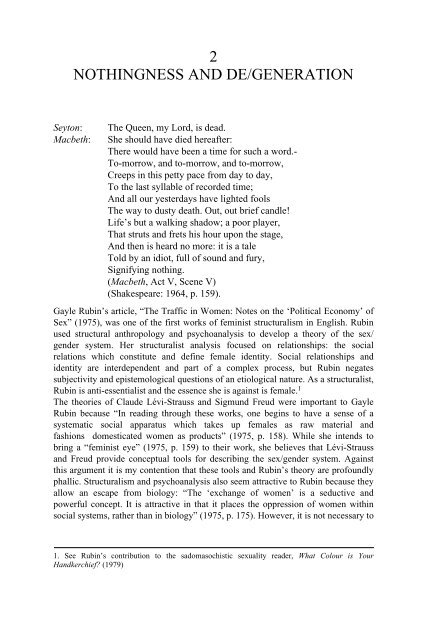Nothing Mat(t)ers: A Feminist Critique of Postmodernism
Nothing Mat(t)ers: A Feminist Critique of Postmodernism
Nothing Mat(t)ers: A Feminist Critique of Postmodernism
Create successful ePaper yourself
Turn your PDF publications into a flip-book with our unique Google optimized e-Paper software.
2<br />
NOTHINGNESS AND DE/GENERATION<br />
Seyton:<br />
Macbeth:<br />
The Queen, my Lord, is dead.<br />
She should have died hereafter:<br />
There would have been a time for such a word.-<br />
To-morrow, and to-morrow, and to-morrow,<br />
Creeps in this petty pace from day to day,<br />
To the last syllable <strong>of</strong> recorded time;<br />
And all our yesterdays have lighted fools<br />
The way to dusty death. Out, out brief candle!<br />
Life’s but a walking shadow; a poor player,<br />
That struts and frets his hour upon the stage,<br />
And then is heard no more: it is a tale<br />
Told by an idiot, full <strong>of</strong> sound and fury,<br />
Signifying nothing.<br />
(Macbeth, Act V, Scene V)<br />
(Shakespeare: 1964, p. 159).<br />
Gayle Rubin’s article, “The Traffic in Women: Notes on the ‘Political Economy’ <strong>of</strong><br />
Sex” (1975), was one <strong>of</strong> the first works <strong>of</strong> feminist structuralism in English. Rubin<br />
used structural anthropology and psychoanalysis to develop a theory <strong>of</strong> the sex/<br />
gender system. Her structuralist analysis focused on relationships: the social<br />
relations which constitute and define female identity. Social relationships and<br />
identity are interdependent and part <strong>of</strong> a complex process, but Rubin negates<br />
subjectivity and epistemological questions <strong>of</strong> an etiological nature. As a structuralist,<br />
Rubin is anti-essentialist and the essence she is against is female. 1<br />
The theories <strong>of</strong> Claude Lévi-Strauss and Sigmund Freud were important to Gayle<br />
Rubin because “In reading through these works, one begins to have a sense <strong>of</strong> a<br />
systematic social apparatus which takes up females as raw material and<br />
fashions domesticated women as products” (1975, p. 158). While she intends to<br />
bring a “feminist eye” (1975, p. 159) to their work, she believes that Lévi-Strauss<br />
and Freud provide conceptual tools for describing the sex/gender system. Against<br />
this argument it is my contention that these tools and Rubin’s theory are pr<strong>of</strong>oundly<br />
phallic. Structuralism and psychoanalysis also seem attractive to Rubin because they<br />
allow an escape from biology: “The ‘exchange <strong>of</strong> women’ is a seductive and<br />
powerful concept. It is attractive in that it places the oppression <strong>of</strong> women within<br />
social systems, rather than in biology” (1975, p. 175). However, it is not necessary to<br />
1. See Rubin’s contribution to the sadomasochistic sexuality reader, What Colour is Your<br />
Handkerchief (1979)

















